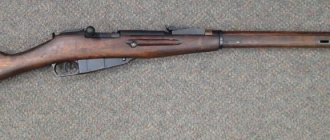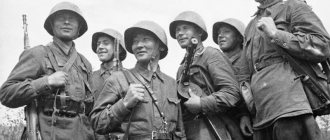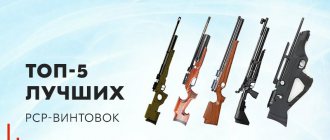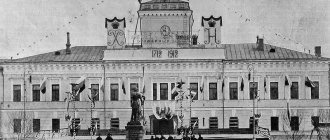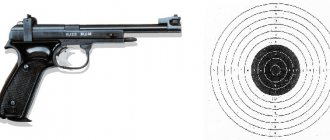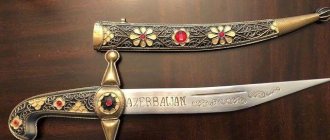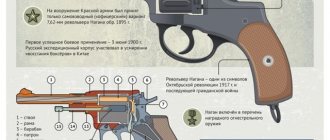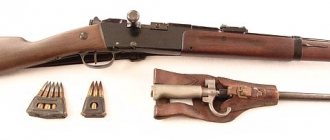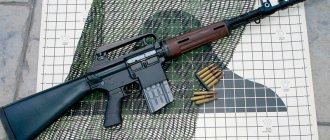Designer Mosin
Sergei Ivanovich Mosin graduated with honors from the oldest military school, the Mikhailovskoye Artillery School, whose founder was Peter the Great. An officer with a solid store of knowledge in higher mathematics, analytical geometry, and artillery disciplines sought to realize his potential in the development of weapons manufacturing in Russia.
In 1882, the Main Artillery Directorate reported on its intended goals; the main task was to create a multi-shot, “repeat” rifle to replace the outdated single-shot “Berdanka”. S.I. Mosin immediately got down to business; in 1883, a pilot batch of 1000 samples was produced at the Tula plant. Offers of a commercial nature began to arrive from abroad; for the talented designer they were not tempting due to personal circumstances. S.I. Mosin refused such offers: firstly, he could not sell the patent, since he was in public service, and secondly, he did not want his weapons to serve someone else’s army.
The development of Captain Mosin competed with the Belgian development of Leon Nagant. Despite all the advantages of the Belgian rifle, it produced twice as many misfires during shooting. Of course, the main advantage of the Russian rifle was its availability in production. A compromise solution by the commission members was found, and in 1891 the S.I. rifle entered service with the Russian army. Mosin with a 5-round magazine of Nagan design. In their final word, they recommend giving the developed model the name “Russian 3-line rifle of the 1891 model.”
Gunsmith's story
Evgeny Dragunov was born on February 20, 1920 in Izhevsk.
Both his father and grandfather were gunsmiths. Dragunov graduated from a seven-year school and the Izhevsk Industrial College. For the USSR at that time it was quite a decent education. Suffice it to say that in the stock shop (where wooden parts of guns were made) at the Izhevsk Machine-Building Plant, where he was assigned, Dragunov was the first to have a technical education. In 1939 he was drafted into the Red Army. For six years he served as a senior gunsmith at the Far Eastern Artillery School, where he was responsible for the serviceability of two thousand rifles, machine guns, and personal weapons of officers.
In January 1946, Evgeny Dragunov returned to Izhmash and began working as a research technician. Then he was appointed design engineer, and even later - leading engineer. Over 40 years of work, Dragunov participated in the development and creation of 50 types of military, sports and hunting weapons. 39 of them were or are being mass-produced. For example, a completely modern Kedr submachine gun (designed by Dragunov).
His passion for sports shooting and hunting helped him develop more than one sports rifle. Many Soviet athletes won competitions and set world records with his weapons.
According to the recollections of his son Mikhail , the main problem with the rifle for biathletes was not the actual shooting elements of the weapon. What turned out to be more difficult was the suspension - a device with which the rifle is attached behind the skier’s back and does not hit him on the head when running. “In my father’s design bureau,” he recalled, “he worked as an engineer who was fond of skiing. And he tested all the samples on himself: he put the rifle on his back and imitated the movements of a biathlete.”
Evgeniy Dragunov died on August 4, 1991, but his weapon is still relevant today. First of all, the Dragunov sniper rifle (SVD).
Father of the Berdanka. In our country he was known as a gunsmith, and in America as a sniper Read more
Russian three-line rifle
On April 16, 1891, Emperor Alexander III approved the model, crossing out the word “Russian,” and the rifle was adopted for service under the name “three-line rifle of the 1891 model.” The only Russian Tsar under whom Russia did not fight broke tradition; this was the first time that a weapon was not named after its creator.
Mosin was given the rights to the individual parts of the rifle he developed and was awarded the highest military-technical award - the Grand Mikhailov Prize; in the summer, Mosin was promoted to colonel of the Guards Artillery.
The Mosin rifle of the 1891 model was adopted in 3 variants: an infantry rifle with a long bayonet and barrel; a cavalry or dragoon rifle with a shorter barrel and a new method of attaching a sling; Cossack rifle without a bayonet and with the shortest barrel. The weapon was launched into mass production in 1892 at the Sestroretsk, Tula and Izhevsk arms factories. In 1894, Sergei Ivanovich was appointed head of the Sestroretsk arms factory. The adoption of the Mosin rifle exposed the country's limited production capacity. It was necessary to attract partners, an order for 500 thousand rifles was placed at the French arms factory in the city of Chatellerault.
LiveInternetLiveInternet
Monday, April 14, 2008 18:18 + to quote book Sergey Ivanovich Mosin
[2(
14).4.1849
, With. Ramon, now Ramon district, Voronezh region, 1/26(8/2).1902, Sestroretsk] Sergei Ivanovich Mosin was born in the village of Ramon, Voronezh province. His father, Ivan Ignatievich, entered military service from the Moscow Orphan Military Department. In 1837 he was promoted to second lieutenant, but a year later he unexpectedly resigned and became the manager of estates and enterprises on a wealthy estate. He marries one of the local peasant girls, Feoktista Vasilyevna. Their son Sergei was not spoiled by life from an early age. Having barely reached the age of four, he lost his mother and was left in the care of his father. He received his initial education with the assistance of the landowner for whom his father worked. On August 16, 1861, Sergei Mosin was accepted into the first general class and enrolled in the “unranked company” of the Tambov Cadet Corps, but in June 1862. transferred to the Voronezh Cadet Corps. The latter was transformed into a military gymnasium in 1865, the broad educational program of which was dominated by exact and natural sciences. In 1867, S.I. Mosin graduated from the gymnasium with honors, in 1870 he graduated from the St. Petersburg Mikhailovsky Artillery School and was promoted to second lieutenant. Having received an appointment to the 2nd Reserve Horse Artillery Brigade, the young officer goes to his duty station. After two years of successful combat service, he received permission to take exams at the Mikhailovsky Artillery Academy, scored a high score and was enrolled in the first year of the technical faculty. In the same year, Sergei Ivanovich was promoted to lieutenant.
In 1875
After graduating from the academy, S.I. Mosin was appointed head of the tool workshop of the Tula Arms Plant. The beginning of his career as a weapons engineer coincided with a period of important improvements in small arms. We are talking about the use of cartridges with a metal sleeve, the construction of so-called magazine rifles, equipped with devices for placing several cartridges to speed up the reloading of weapons. By the 80s. Mosin, with the rank of captain, was already known as a great expert in weapons making. By order of the Main Artillery Directorate in 1881 - 1882. he was appointed a member of the “commission for the inspection of mechanical means and buildings” of the Sestroretsk and Izhevsk plants. This gave him the opportunity to become even more familiar with the organization of production at these factories and the state of the Russian arms industry. At that time, the focus of attention in military circles was the question of rearming the Russian army with a small-caliber repeating rifle. S.I. Mosin, like some other Russian gunsmiths, made an attempt to take part in resolving this issue. At the Tula Arms Plant, Sergei Ivanovich headed the tool workshop for many years, on which all the activities of the enterprise depended. It provided production with measuring and testing tools, patterns, templates; it employed the best craftsmen and, in addition, toolmakers carried out all the experimental work on improving small arms. So, during 1875 - 1876. At the Tula plant, a special commission of artillery captain Rogovtsev worked, whose task was to improve the bolt of a 4.2-line rifle. Mosin actively collaborated with its specialists. Captain Rogovtsev then proposed significant changes that eliminated twisting of the firing pin, breakage of the bolt at the junction of the stem and tail, and a number of other shortcomings. S.I. Mosin himself made his first attempts to test his design abilities back in 1878, when, according to a competition announced by the Artillery Committee, he began designing a device for checking the correctness of the aiming line in rifles of the 1870 model. At the same time, V.L. joined the competition. Chebyshev and the young captain A.V. Kun, who later became the head of the Tula arms factory. Sergei Ivanovich made his own device. It is now difficult to judge how original it was, since no traces of it have survived. And although in 1881 a comparative test of the devices proposed by Mosin, Kuhn and Chebyshev was carried out at the Tula plant, its results are unknown, since the weapons department soon decided that the need for this device was no longer necessary. And yet, despite the failure, Mosin’s baptism as a designer took place. It would be absolutely wrong to consider Sergei Ivanovich a person whose interests were limited only to factory service and rifle design. He lived the life of an ordinary person with his joys and troubles, and the desire to make a military career was not alien to him. But if Mosin rose through the ranks of the ranks thanks to his abilities and efforts quite quickly, the number of stars on his epaulettes did not grow so rapidly. He began his service in the field artillery with the rank of second lieutenant, and arrived in Tula with the rank of staff captain. This rank was third from bottom in Peter’s table of ranks and it was given to Sergei Ivanovich after eight years of service. The difference in the position of army and guards artillery officers was great. In order to attract smart people to military production, the War Ministry insisted on enrolling production officers in the guard, which made it possible to increase salaries and give other privileges to these workers. As a result of this, by the Highest Order, which followed on August 23, 1876, “Staff Captain Mosin, who was assigned to the field horse artillery, was transferred to the Guards Horse Artillery and assigned to it as a lieutenant.” The reduction in rank by one step was due to the same rule according to which army officers were automatically inferior to guardsmen in promotion in rank. But the next year, Sergei Ivanovich was promoted to staff captain due to a vacancy, and in 1880, again due to a vacancy, he received captain’s shoulder straps “in the Guards Horse Artillery.” By this time, Mosin was 31 years old, some of his colleagues were already trying on colonel's shoulder straps, and in order to receive this high rank, Sergei Ivanovich needed to invent the best rifle in the world. Mosin back in 1882 independently began work on converting a single-shot Berdan rifle into a repeating rifle. The commission for testing repeating rifles involved him in its work, among other Russian gunsmiths known to it. In the summer of 1883, he presented the samples of repeating rifles he had developed for consideration by the commission. For the Berdan rifle, S.I. Mosin installed a rack and pinion magazine for 8 rounds. The essence of the store's design was boiled down to the following: the cartridges were placed in an oval tube located inside the butt. To feed the cartridges, a rail was used, the teeth of which captured the edges of the cartridge. The rack was engaged with the bolt. When the bolt was pulled back, the rail fed the cartridge so much that it could be captured by the bolt. The cartridges in the magazine were located obliquely, so that the bullet of one cartridge did not rest against the capsule of another, which led to the complete safety of Mosin’s magazine and distinguished his rifle from foreign systems. A rifle of this type, now kept in the weapons museum at the Tula Arms Factory, was finally developed by Mosin by the beginning of 1884. Somewhat later, Mosin created the same type of rifle with 12 rounds. While in St. Petersburg with his first rifles, Sergei Ivanovich met with V.L. Chebyshev and I.A. Vyshnegradsky and learned that there were heated debates among scientists and major military figures about the prospects and capabilities of multi-charge or, as they said then, repeating weapons. It would seem that the lessons of the Balkan War should have clearly resolved the question: to be or not to be repeating rifles. However, in military circles there were many supporters of the traditional rule “shoot rarely, but shoot accurately.” They believed that repeating rifles could have a right to exist if one soldier needed to be killed several times. Even such an advanced general, military theorist and teacher, who considered it necessary to instill in soldiers a conscious attitude towards their military duties, like General Mikhail Ivanovich Dragomirov, was an opponent of magazine weapons. His ideal was a single-shot rifle with a caliber of about eight millimeters chambered in a cartridge with pressed gunpowder and a steel-jacketed bullet. The opinion of Professor V.L. was unequivocal. Chebyshev, who unconditionally supported magazine weapons and demanded the most serious work on their improvement. In July 1883, S.I. Mosin was appointed a member of the special commission for testing repeating rifles. This was official recognition of him as one of the leading experts in the field of small arms. The commission carried out the next tests of repeating rifles in 1884, and in accordance with the instructions of the State Autonomous Institution, S.I. Mosin was sent to St. Petersburg. He rode in high spirits, because just before the trip he learned that he had been awarded the Bulgarian Order of St. Alexandra 4th degree. This was his first award. Sergei Ivanovich took a direct part in testing his own rifle, listened carefully to comments, absorbed everything new that he managed to learn at the training ground and in conversations with colleagues. The rifle he brought was again approved, but, of course, could not be put into service due to a number of shortcomings. The decision of the commission did not disappoint Sergei Ivanovich, but only gave him confidence in the ultimate success of the planned business and, accordingly, new strength. In 1885, the arms department ordered the Tula Arms Plant 1000 rifles with a Mosin magazine for military testing. It is characteristic that this invention, due to the connivance of tsarist officials who did not know how to keep military secrets, became known abroad, where at that time urgent research was underway in the field of magazine weapons. Having learned about Mosin's invention, foreigners decided to outbid him. In 1885, on behalf of a Parisian company, Mosin was offered 600 thousand francs, and then the amount reached 1 million, for the right to use the rack-and-pinion mechanism he invented for a French rifle. Foreigners were forced to recognize the superiority of the Russian invention, the value of the works of the outstanding Russian designer S.I. Mosin. Mosin had very modest means and lived on his captain's salary. However, he decisively rejected all proposals from foreigners, acting like a true Russian patriot, selflessly devoted to the Motherland. Of course, all Russian gunsmith designers combined inventive activity with the performance of direct official duties, but probably no one was loaded with as much extraneous work as Mosin. He constantly combined several positions. The management appreciated his ability to work and, as a reward for this, at the end of August 1886, Sergei Ivanovich was awarded the Order of St. Vladimir 4th degree. Mosin was sincerely touched by this high honor. The planned rearmament of the Russian army promised huge profits to foreign arms manufacturers, who were in a hurry to take advantage of it. However, presented to the commission in the fall of 1889. The samples of repeating rifles known at that time by Lebel, Mannlicher, Nagant and others turned out to be “unsatisfactory either in the design of the magazine or in the fragility and inconvenience of the bolt.” With a strict and impartial approach to evaluating foreign rifles, the myth about the notorious “superiority” of Western European weapons technology turned out to be clearly untenable. The sending of foreign repeating rifles to the commission turned out to be a convenient excuse for Mosin to ask permission to return to work on creating his own repeating rifle. The commission gave its consent to this. Mosin began designing his repeating rifle, as we indicated, much earlier than Nagan and other foreign designers, whose rifle samples were tested by the commission. The Russian designer thus took on the task of solving the most difficult technical problems that the most famous and experienced European gunsmiths could not successfully complete. While Mosin was in Tula, the Belgian manufacturer and weapons designer Nagan presented the commission with his new models of rifles. When testing Nagant rifles, carried out in the spring of 1890 in the presence of the designer, they jammed the cartridges and “did not have a device that prevented the untimely release of two cartridges from the magazine.” 1889 - 1891 were a period of work with guns by two designers - the Belgian L. Nagan and the Russian S.I. Mosin, whose rivalry led to the appearance of a rifle remarkable in its properties. On March 11, 1889, the Main Artillery Directorate ordered Captain Mosin to assume the position of chairman of the selection committee of the Tula Arms Plant. The appointment was doubly pleasant for him. Firstly, he had time to work on the rifle, and secondly, his brother Mitrofan was a member of this commission. Mosin Jr., after studying at the Moscow Military Gymnasium, graduated from the Tiflis Junker School in June 1873. Mitrofan Ivanovich took part in the Balkan campaign and was awarded the Order of St. Anne 4th degree and St. Stanislav 3rd degree. It is possible that he got to the arms factory with the help of his older brother. Mosin's design method was distinguished by great initiative. He usually gave only the basic dimensions of the parts and data that determined their relative position in the rifle sample. The remaining “free dimensions of parts” were determined by the designers and draftsmen. Then the sketch in the form of a normal drawing was sent to Mosin, who made the final edits, sometimes changing the dimensions and even the very shape of the parts. Mosin was very attentive to all stages of rifle design. He was directly involved in the preparation and verification of working drawings, constantly visited workplaces, especially during assembly, helping assemblers technically and sometimes with practical instructions, and personally monitored the production of parts for the first prototype rifles in the plant’s workshops. After a long time, the time came to promote Mosin to the next rank - after all, it was awkward for him, a world-famous inventor, to serve as a captain for 11 years. At the beginning of August 1891, Sergei Ivanovich’s uniform was decorated with epaulettes of a guards artillery colonel. On August 21, 1891, Sergei Ivanovich submitted his rifle for the Grand Mikhailov Prize, attaching drawings, a brief description of the weapon and rules for handling it. The Mikhailovsky Prize was the most prestigious award for inventions in the field of artillery and weapons. It was awarded once every five years, because its founders rightly believed that outstanding inventions do not appear more often. On November 25, Mosin received notification that the Main Artillery Directorate had awarded him the highest military-technical award of the Russian army. This was the final recognition of not only his merits, but also the actual recognition of his co-authorship of the Russian repeating rifle. In 1892 he was awarded the Order of St. Anna 2nd degree. On April 21, 1894, Colonel S.I. Mosin, chairman of the selection committee of the Imperial Tula Arms Factory, was appointed acting head of the Sestroretsk Arms Factory. The famous designer was given a ceremonial farewell. A touching farewell took place on the platform of the Kursk station in Tula. Shortly before the train departed, Tula craftsmen handed Sergei Ivanovich an oblong case of black chrome leather. In it rested on blue velvet a miniature rifle of the 1891 model. For Sergei Ivanovich, there was no reward more valuable than this wonderful creation of working hands. S.I. Mosin and all gunsmiths brought great success. In 1900, at the World Exhibition in Paris, the 3-line rifle was awarded the highest award - the Grand Prix. This was international recognition of the merits of the inventor and the entire Russian industry, in the rise of which Mosin played a significant role. In general, after 1894, awards and honors showered on Sergei Ivanovich. Arriving in Sestroretsk, he became not only the head of the plant, but also the head of the Sestroretsk garrison. In December 1894, he was elected an advisory member of the Artillery Committee of the GAU, and the following year he was awarded the Order of St. Vladimir 3rd degree, then a Silver medal in memory of Alexander II. In 1898, his chest was decorated with the Bukhara Order of the Golden Star, 3rd degree, and finally, on April 9, 1900, Sergei Ivanovich was promoted to general. The exceptionally useful activity of General Mosin was interrupted quite early. In mid-January 1902 Sergei Ivanovich caught a cold, a few days later he felt worse, the doctor called diagnosed lobar pneumonia, began treatment, but it was too late - the disease had become irreversible. On January 26, 1902, at about four o'clock in the afternoon, the outstanding Russian weapons designer died. source: ruscadet.ru https://d-pankratov.livejournal.com/
Comments: | Comment on Blog.ru
Cited 1 time
Like share
0
Like
- I liked the post
- Quoted
- 0
Saved
- Add to quote book
- 0
Save to links
Liked
0
Weapons of the Revolution
The “three-line” model of 1891 was the main weapon of the 1917 revolution, took part in the Russian-Japanese (approximately 3,800,000 rifles were supplied to the army), the First World War (at the time Russia entered the war, the army had 4,519,700 rifles in service) , as well as the Great Patriotic War.
In 1900 S.I. Mosin received the rank of general in his homeland and the Grand Prix for his “three-line” at the Paris Exhibition. The name comes from the caliber of the rifle barrel: the old measure of length is an inch, equal to 2.54 mm - three lines equal 7.62 mm, i.e. three lines into which an inch is divided.
In his notes, Sergei Ivanovich wrote with some resentment and with good reason that all the main parts and mechanisms of the rifle were undoubtedly developed by him, these parts determine the system as a whole, but the name of the developer S.I. Mosin received weapons already in Soviet times, during the process of modernization in 1930. In the USSR, the outstanding Russian rifle was produced until 1944; in 1960, the S.I. Mosin Prize was established; since 1999 it has been awarded annually; it was removed from service in the 1970s.
There are different types of snipers
In Russia, the term “sniper” usually means a highly qualified professional who knows how to camouflage himself on the ground and can lie in ambush for hours without moving. He fights duels with enemy snipers, in which the one with the stronger nerves wins. In short, something between the legendary Stalingrad Vasily Zaitsev (by the way, he participated in military tests of the SVD) and the character of the American film “Sniper” performed by Tom Berenger . So: the Dragunov rifle was not created for them.
SVD is the weapon of those who in Russian are called infantry snipers, and in English - designated marksman (designated shooter), or simply marksman. The main difference is that the sniper shot range starts at approximately 500 meters. The Marksman's range limit is a maximum of 700 meters. He acts exclusively in the interests of his squad, destroying enemy machine gunners, grenade launchers, signalmen, officers... Although there were exceptions. During the war in Afghanistan, Sergeant Vladimir Ilyin killed the leader of the Mujahideen at a distance of 1350 m. By the way, during that war, the SVD was nicknamed the “oar” by the troops for the characteristic shape of its butt.
"Killed a thousand Germans." Why wasn't the best sniper of the war given a Hero Star? More details

